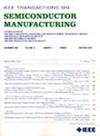基于扩散模型的虚拟硅数据生成方法
IF 2.3
3区 工程技术
Q2 ENGINEERING, ELECTRICAL & ELECTRONIC
引用次数: 0
摘要
硅数据允许设计人员通过利用机器学习技术来提高芯片性能。通过深入了解晶圆内感兴趣的特征分布,设计人员可以更准确地预测芯片的行为。然而,真正的硅数据可能并不总是可用的。这项工作提出了一种生成高质量合成硅数据的方法,并通过几个指标验证了其有效性。通过芯片探测(CP)和晶圆验收测试(WAT)获得的硅特征相结合,可以创建更全面的数据,从而进行设计-技术协同优化(DTCO)。与先前工作中使用的基于生成对抗网络(GAN)的方法不同,这项工作利用扩散模型来生成合成硅数据。采用Jensen-Shannon (JS)散度相似性和Frechet Inception Distance (FID)分别评价合成数据的分布和量化合成数据的质量。实验结果表明,该扩散模型能够更准确地提取多特征硅数据分布,平均JS散度相似度为0.987,FID为6.28。这种方法能够生成大量的硅样品,用于广泛的硅数据分析和DTCO加速。本文章由计算机程序翻译,如有差异,请以英文原文为准。
A Diffusion-Model-Based Methodology for Virtual Silicon Data Generation
Silicon data allow designers to enhance the chip performance by leveraging machine learning techniques. By gaining a deeper understanding of the distributions of interested features within a wafer, designers can predict chip behaviors more accurately. However, real silicon data may not always be available. This work presents a methodology for generating high-quality synthetic silicon data and verifies its effectiveness through several metrics. Silicon features obtained by chip probing (CP) and wafer acceptance test (WAT) are combined to create more comprehensive data, enabling to conduct design-technology co-optimization (DTCO). Unlike the generative adversarial network (GAN) based methodology used in prior work, this work utilizes a diffusion model to generate synthetic silicon data. The Jensen-Shannon (JS) divergence similarity and Frechet Inception Distance (FID) are used to evaluate the distribution and to quantify the quality of synthetic data, respectively. Experimental results demonstrate that the diffusion model is able to extract the multi-feature silicon data distribution more accurately, with an average JS divergence similarity of 0.987 and an FID of 6.28. This methodology enables to generate a substantial volume of silicon samples for extensive silicon data analysis and DTCO acceleration.
求助全文
通过发布文献求助,成功后即可免费获取论文全文。
去求助
来源期刊

IEEE Transactions on Semiconductor Manufacturing
工程技术-工程:电子与电气
CiteScore
5.20
自引率
11.10%
发文量
101
审稿时长
3.3 months
期刊介绍:
The IEEE Transactions on Semiconductor Manufacturing addresses the challenging problems of manufacturing complex microelectronic components, especially very large scale integrated circuits (VLSI). Manufacturing these products requires precision micropatterning, precise control of materials properties, ultraclean work environments, and complex interactions of chemical, physical, electrical and mechanical processes.
 求助内容:
求助内容: 应助结果提醒方式:
应助结果提醒方式:


